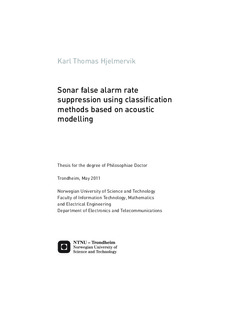| dc.contributor.author | Hjelmervik, Karl Thomas | nb_NO |
| dc.date.accessioned | 2014-12-19T13:47:07Z | |
| dc.date.accessioned | 2015-12-22T11:46:07Z | |
| dc.date.available | 2014-12-19T13:47:07Z | |
| dc.date.available | 2015-12-22T11:46:07Z | |
| dc.date.created | 2012-01-03 | nb_NO |
| dc.date.issued | 2011 | nb_NO |
| dc.identifier | 499815 | nb_NO |
| dc.identifier.isbn | 978-82-471-2795-7 (printed ver.) | nb_NO |
| dc.identifier.isbn | 978-82-471-2796-4 (electronic ver.) | |
| dc.identifier.uri | http://hdl.handle.net/11250/2370383 | |
| dc.description.abstract | The use of high–resolution, active sonar systems in littoral environments often results in high false alarm rates. False alarm rate inflation (FARI) and non–Rayleigh reverberation (NRR) are two well–documented causes. FARI may occur when the reverberation in the normaliser window is non–stationary, while NRR may occur when the sonar footprint is too small for the central limit theorem to apply for the scatterer statistics. The main originator for false alarms in littoral environments are either the sea floor itself or objects located on the sea floor.
Automatic classification methods may be used to reduce the false alarm rate. Conventionally, advanced sonar processing or image processing techniques have been used directly on received data. Increased availability of environmental information allows for more sophisticated algorithms that employ acoustic modelling to extract more information from recorded data.
This thesis addresses two topics of interest. The first topic is on how acoustic modelling combined with environmental knowledge may be used to increase the ability of anti–submarine warfare sonars to classify a detected target. The second topic is on how environmental uncertainty may be reduced in order to improve the fidelity of the proposed classification algorithms. | nb_NO |
| dc.language | eng | nb_NO |
| dc.publisher | Norges teknisk-naturvitenskapelige universitet, Fakultet for informasjonsteknologi, matematikk og elektroteknikk, Institutt for elektronikk og telekommunikasjon | nb_NO |
| dc.relation.ispartofseries | Doktoravhandlinger ved NTNU, 1503-8181; 2011:128 | nb_NO |
| dc.relation.haspart | Hjelmervik, Karl Thomas. Predicting Sonar False Alarm Rate Inflation Using Acoustic Modeling and a High-Resolution Terrain Model. IEEE Journal of Oceanic Engineering. (ISSN 0364-9059). 35(2): 278-287, 2010. <a href='http://dx.doi.org/10.1109/JOE.2009.2038735'>10.1109/JOE.2009.2038735</a>. | nb_NO |
| dc.relation.haspart | Hjelmervik, Karl Thomas. Target depth estimation using a ray backpropagation scheme on sonar data – simulations and experiments. | |
| dc.relation.haspart | Hjelmervik, Karl Thomas. Target depth estimation using a ray backpropagation scheme on mid-frequency, active sonar data. , 2010. | |
| dc.relation.haspart | Hjelmervik, Karl Thomas. Inverting the water column sound speed. Presented at the ECUA Conference, 2010. | |
| dc.relation.haspart | Jensen, Jan Kristian; Hjelmervik, Karl Thomas; Østenstad, Petter. Finding acoustically stable areas through EOF classification. IEEE Journal of Oceanic Engineering. (ISSN 0364-9059), 2011. <a href='http://dx.doi.org/10.1109/JOE.2011.2168669'>10.1109/JOE.2011.2168669</a>. | |
| dc.title | Sonar false alarm rate suppression using classification methods based on acoustic modelling | nb_NO |
| dc.type | Doctoral thesis | nb_NO |
| dc.contributor.department | Norges teknisk-naturvitenskapelige universitet, Fakultet for informasjonsteknologi, matematikk og elektroteknikk, Institutt for elektronikk og telekommunikasjon | nb_NO |
| dc.description.degree | PhD i elektronikk og telekommunikasjon | nb_NO |
| dc.description.degree | PhD in Electronics and Telecommunication | |

